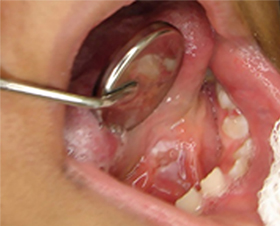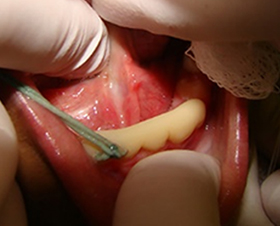INTRODUCTION
Cerebral palsy (CP) describes a group of permanent disorders that involves loss or impairment of motor function and is attributed to non-progressive disturbances in infant brain. CP motor disorders are often accompanied by secondary musculoskeletal problems and disturbances of sensation, perception, cognition, communication and behavior.1 This condition is the most common cause of severe physical disability in childhood with prevalence of 2.4 per 1 000 children.2
Self-inflicted injuries have been described as uncoordinated myotonic activity of select masticatory muscles and the tongue following neurological damage in individuals with moderate to severe neurological impairments. The chewing movements produced are clenching spasms, biting, gnawing and bruxing.3,4) Different approaches can be used to prevent and treat self-inflicted oral injuries in individuals with CP, such as oral appliances, botulinum toxin type A neuromuscular block and oral surgery. Low-level laser therapy (LLLT) has also been found to be effective when applied to traumatic injuries in patients presenting self-inflicted oral trauma.5,6,7,8
Few case reports involving children with CP with self-inflicted oral trauma are described in the literature.6) Moreover, no previous study described the use of different treatment modalities for the management in the same patient. Thus, the aim of this case report was to describe two treatment modalities (LLLT and fixed oral appliance) for self-inflicted oral trauma in a 6-year-old male with quadriplegic spastic CP over a 5-year follow-up period.
CASE PRESENTATION
A 6-year-old male with quadriplegic spastic CP was brought to the Clinic for Special Needs Patients at the Cruzeiro do Sul University, São Paulo, Brazil for dental treatment. Informed consent was provided by the child’s guardian.
An evaluation of the patient indicated that his phenotypic features included activity limitations, musculoskeletal problems and disturbances of cognition and communication. The child had a feeding tube for formula, liquids and medicines. A clinical examination identified the presence of biofilm on primary teeth surfaces, tongue interposition and traumatic severe wounds to the mouth floor and lingual fraenum regions.
The lesions were 0.5 mm diameter, circumferential ulcerated and whitish with a reddish central area. His past dental history indicated that the parafunctional oral habits were related to traumatic wounds (Fig. 1) due to the presence of hypertonic tongue associated with the protrusion reflex and respiratory distress.

Fig. 1 At 6 years old, the first occurrence of traumatic oral wounds to the mouth floor and lingual fraenum regions.
The initial treatment proposed was LLLT with low-intensity Gallium-Aluminium-Arsenide diode laser (Eccofibras Industry, Campinas, SP, Brazil), emitting a continuous laser beam at 660 nm wavelength, 50 mW power output with an effective dose of 4 J/cm² per point and duration of 1 minute and 20 seconds. Treatment was performed with the child stabilised for protection and the use of wooden spatulas to facilitate mouth opening. The child received four sessions of LLLT with 24, 48 and 72 hour intervals. After four applications, traumatic wounds showed reduction in size and acceleration in the healing process. The child attended a dental recall to control oral health every 6 months, with no signs of self-inflicted oral trauma.
At age 11, the child presented with a new traumatic wound in a region of the mouth floor. This lesion was approximately 1.0 cm in diameter, did not yield to the scraping surface roughness, was asymptomatic and ulcerated in a small central area (Fig. 2). The habit of tongue interposition probably resulted in the chronic severe oral trauma.
The proposed treatment was placement of an oral appliance made of heat- cured acrylic resin. The provisional prosthesis covered all tooth surfaces of the anterior permanent teeth. An impression of the oral vestibule of the anterior teeth was taken using condensation silicone. The oral appliance was fixed to the crowns of the mandibular anterior teeth with dental zinc phosphate cement. The appliance was 0.5 cm in thickness, with polished cervical adaptation. Dental floss was attached to it for security. The appliance presented minimal interference with oral hygiene procedures and 0.12 % solution of chlorhexidine embedded in gauze was used for biofilm control gently apply once a day during 4 weeks.
The child was monitored every week for one month. Seven days after placement of the fixed oral appliance, the guardian reported that the child had adapted well to the appliance. After two weeks, a positive result was observed and the wound reduced significantly (Fig. 3). Intraoral examination showed that the wounds had healed completely after four weeks, and the oral appliance was subsequently removed.
DISCUSSION
Several management methods have been suggested for oral trauma, depending on the severity, frequency and cause of injury. These include medication, behavioural techniques, the use of oral appliances, laser therapy or dental extractions.3,5,7) Based on our findings, LLLT and placement of a fixed oral appliance were effective non-invasive dental approaches to treat self-inflicted oral trauma in a child with CP.
Higher oral trauma risk is observed in individuals with CP with higher neurological damage. In addition, pain and loss of function of dental and periodontal tissues, functional, aesthetic, psychological and social damages are involved, negatively affecting the quality of life of these individuals.4,9 In the present case, the self-inflicted oral trauma was related to a parafunctional habit of tongue interposition. Severe neuromuscular dysfunction associated with spasticity and tonic bite reflex, with interposition of soft tissues between the dental arches, results in soft-tissue trauma due to the lack of protective reflexes caused by the mandible movement disorders resulting from spasticity.10 Tongue interposition is a parafunctional oral habit most frequently present in CP patients.11,12 It should be stated that parafunctional habits are actions which negatively affect oral structures. The harmful effect occurs when the habit overlaps the dynamics of the physiological tissues in both intensity and frequency.11
Traumatic ulcers can occur in the oral cavity due to different aetiological factors, including repetitive trauma.13 These lesions can persist for 10 to 14 days, causing moderate to severe pain.13,14 LLLT was effective in accelerating the healing process and regression of the wounds. It is known that laser therapy aids inflammatory responses, resulting in oedema and pain reduction and cellular biostimulation.13 LLLT can be used as an alternative approach for inflammation and pain control in traumatic oral ulcers.15,16
A randomized clinical trial described the effects of LLLT for the treatment of traumatic oral ulcers. LLLT treatment significantly reduced pain immediately after the first application and aided tissue repair in the healing process.17 In this context, it should be emphasized that LLLT is a non-invasive approach18 that should be considered by dental professionals for the treatment of traumatic oral wounds in individuals with special needs.
Here, LLLT was successfully applied to less severe wounds at age 6. However, at age 11 the child presented increased parafunctional habits in his tongue and the wound was more severe and larger. Consequently, there was a need to control this habit, mainly in the region of the ulcer. The proposed treatment involved placement of a fixed oral appliance to deflect soft tissues from the occlusal plane, allowing healing of the injured tissues. The appliance was easily prepared and presented no risk to the patient. (7,10
Considering the philosophy of minimally invasive dentistry, self-inflicted oral trauma in children with CP can be controlled and treated with LLLT and fixed oral appliances. Randomized clinical trials are encouraged to elucidate the effectiveness of different treatment modalities for the management of self-inflicted oral trauma. Since traumatic ulcers are frequently recurrent lesions, it is important to control the patient to enable the effects of these non-invasive treatment modalities. Multidisciplinary approaches should be considered in this clinical condition. The interaction between pedodontics and laser therapy and prosthodontics provides a conservative therapy minimizing self-mutilation and promoting improvements in quality of life.
It can be concluded that LLLT and placement of fixed oral appliances were effective approaches for the treatment of self-inflicted oral trauma in this children with CP. It is important to combine different therapies in such patients to evaluate the efficacy in preventing recurrence of these oral injuries.
















